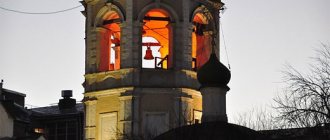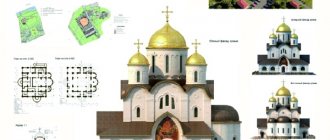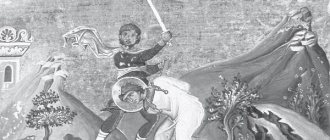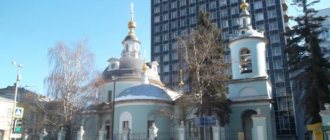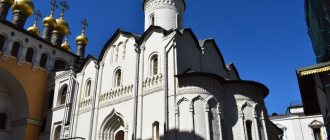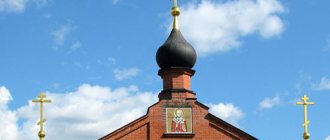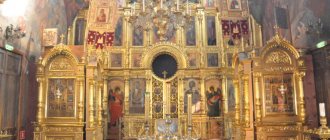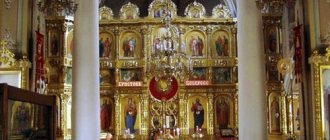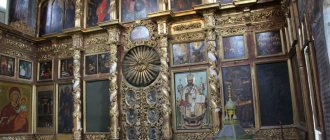Mir
Russia Moscow Temple of the Deposition of the Blessed Virgin Mary in Leonovo (Moscow) Map is loading…
{"format":"leaflet","minzoom":false,"maxzoom":false,"limit":50,"offset":0,"link":"all","sort":[""], "order":[],"headers":"show","mainlabel":"","intro":"","outro":"","searchlabel":"\u2026 \u0441\u043b\u0435\ u0434\u0443\u044e\u0449\u0438\u0435 \u0440\u0435\u0437\u0443\u043b\u044c\u0442\u0430\u0442\u044b","default":"","import-annotation":false,"width ":"auto","height":"350px","centre":{"text":"","title":"""link":"""lat":55.8414444000000003143213689327239990234375,"lon": 37.64424999999999954525264911353588104248046875,"icon":""},"title":"","label":"","icon":"","lines":[],"polygons":[], "circles":[ ],"rectangles":[],"copycoords":false,"static":false,"zoom":8,"defzoom":14,"layers":["OpenStreetMap"],"image layers":[] ,"overlays":[],"resizable":false,"fullscreen":true,"scrollwheelzoom":true,"cluster":false,"clustermaxzoom":9,"clusterzoomonclick":true,"clustermaxradius":80, "clusterspiderfy":true,"geojson":"","clicktarget":"","showtitle":true,"hidenamespace":false,"template":"","userparam":"","activeicon": "","pagelabel":false,"ajaxcoordproperty":"","ajaxquery":"","locations":[{"text":"\u003Cb\u003E\u003Ca href=\"/palomnik/%D0% A5%D1%80%D0%B0%D0%BC_%D0%A0%D0%B8%D0%B7%D0%BE%D0%BF%D0%BE%D0%BB%D0%BE%D0%B6% D0%B5%D0%BD%D0%B8%D1%8F_%D0%9F%D1%80%D0%B5%D1%81%D0%B2%D1%8F%D1%82%D0%BE%D0% B9_%D0%91%D0%BE%D0%B3%D0%BE%D1%80%D0%BE%D0%B4%D0%B8%D1%86%D1%8B_%D0%B2_%D0%9B% D0%B5%D0%BE%D0%BD%D0%BE%D0%B2%D0%B5_(%D0%9C%D0%BE%D1%81%D0%BA%D0%B2%D0%B0)\ » title=\»\u0425\u0440\u0430\u043c \u0420\u0438\u0437\u043e\u043f\u043e\u043b\u043e\u0436\u0435\u043d\u0438\u044f \u041f\u0440\u 0435\u0441\u0432\ u044f\u0442\u043e\u0439 \u0411\u043e\u0433\u043e\u0440\u043e\u0434\u0438\u0446\u044b \u0432 \u041b\u0435\u043e\u043d\u043e\u 0432\u0435 (\u041c\u043e\u0441 \u043a\u0432\u0430)\»\u003E\u0425\u0440\u0430\u043c \u0420\u0438\u0437\u043e\u043f\u043e\u043b\u043e\u0436\u0435\u043d\u043 8\u044f\u041f\u0440\ u0435\u0441\u0432\u044f\u0442\u043e\u0439 \u0411\u043e\u0433\u043e\u0440\u043e\u0434\u0438\u0446\u044b \u0432 \u041b\u0435\u 043e\u043d\u043e\u0432\u0435 ( \u041c\u043e\u0441\u043a\u0432\u0430)\u003C/a\u003E\u003C/b\u003E\u003Chr /\u003E\u003Ca href=\"/palomnik/%D0%A1%D0%B2%D0% BE%D0%B9%D1%81%D1%82%D0%B2%D0%BE:%D0%90%D0%BD%D0%BD%D0%BE%D1%82%D0%B0%D1%86 %D0%B8%D1%8F\" title=\"\u0421\u0432\u043e\u0439\u0441\u0442\u0432\u043e:\u0410\u043d\u043d\u043e\u0442\u0430\u0446\u0438\u044f\ »\u003E\u0410\u043d\u043d\u043e\u0442\u0430\u0446\u0438\u044f\u003C/a\u003E: »'\u0425\u0440\u0430\u043c \u0432 \u0447\u0435 \u0441\u0442\u044c \u041f\u043e\u043b\u043e\u0436\u0435\u043d\u0438\u044f \u0420\u0438\u0437\u044b \u041f\u0440\u0435\u0441\u0432\u044f\u0442\ u043e\u0439 \u0411\u043e\u0433 \u043e\u0440\u043e\u0434\u0438\u0446\u044b \u0432\u043e \u0412\u043b\u0430\u0445\u0435\u0440\u043d\u0435 \u0432 \u0431\u044 b\u0432\u0448\u0435\u043c\u0441 '' 3e\u0439\u0445\u0440\u0430 \u043c \u041c\u043e\u0441\u043a\u043e\u0432\u0441\u043a\u043e\u0433\u043e \u041f\u0430\u0442\u0440\u0438\u0430\u0440\u0445\ u0430\u0442\u0430; ""title":"\u0425\ u0440\u0430 \u043c \u0420\u0438\u0437\u043e\u043f\u043e\u043b\u043e\u0436\u0435\u043d\u0438\u044f \u041f\u0440\u0435\u0441\u0432\u044f\ u0442\u043e\u0439\u0411\u043e \u0433\u043e\u0440\u043e\u0434\u0438\u0446\u044b \u0432 \u041b\u0435\u043e\u043d\u043e\u0432\u0435 (\u041c\u043e\u0441\u043a \u0432\u0430)","link ":"","lat":55.8414444000000003143213689327239990234375,"lon":37.64424999999999954525264911353588104248046875,"icon":""}],"imageLayers":[] }
55.841599; 37.644216
Russia, Moscow, Dokukina street, 15с1
Moscow
Russia
Telephone:
(499) 181-01-41.
Temple in honor of the Placing of the Robe of the Blessed Virgin Mary in Blachernae in the former village of Leonovo
— parish church of the Moscow Patriarchate; Trinity Deanery.
History[edit]
The Levonov Heath was first mentioned in the scribe books of 1573–1574. In 1626, Leonovo was granted to Prince Ivan Nikitich Khovansky, who soon erected a wooden Church of the Deposition of the Robe on the very spot where the current temple stands. The first mention of it was in 1633.
Stone temple, built in 1719–1722. made of stone, was consecrated in 1722 on the day of the Feast of the Laying of the Robe of the Most Holy Theotokos (July 2, Art.).
The church was closed in 1800, and it “remained without singing until 1859,” falling into complete desolation. In 1812, Napoleon's troops desecrated the church by building a stable in it. In 1859, the manufacturer Molchanov, who had recently built the Rostokinskaya cotton-printing factory, renovated the temple for the spiritual needs of his workers.
After the October revolution, the Temple of the Deposition of the Robe was also attacked by the atheistic authorities. According to the agreement of December 17, 1918 between the district Council of Deputies and parishioners, the Leonovsky church was transferred to believers for free use. In the same year, a significant number of icons and, mainly, church utensils were transferred to the Leonov church from the St. Michael's Church of the Grodno diocese. During the Great Patriotic War, the temple made large contributions to the Red Army fund. There is evidence that in different years the temple was visited by Moscow Patriarchs: Alexei I, Pimen, Alexei II.
Several icons of old writing have been preserved in the church, probably transferred from a wooden church of the 17th century. These are two identical in size, picturesque style of writing and design of the image of the Virgin Mary from the beginning of the 18th century. - “Quench my sorrows” and Kazansky, located one opposite the other at the side walls. The temple image of the “Position of the Honorable Robe of the Mother of God” was made in oil in the 19th century.
In the Church of the Deposition of the Mother of God in Leonovo in the 20th century, wonderful shepherds served in different years, who made a significant contribution to the strengthening of Orthodoxy on Russian soil. Thus, after the end of the war, the future elder schema-abbot Savva (Ostapenko, 1898–1980), who labored in the Pskov-Pechersky Monastery during the Soviet years, served as an altar boy in the church.
How are the services held?
The Divine Liturgy in Leonovsky Church is served daily at 9.00, and the evening service at 17.00; on Sundays and twelve holidays, the early Liturgy begins at 7.00 and the late one at 10.00. During the summer period from July to September there is one Liturgy at 9.00.
Prayers and conversations in the Temple of the Placing of the Robe:
- On Sundays at 12.00 a prayer service is held in front of the “Inexhaustible Chalice” icon for those suffering from drunkenness and drug addiction. At 17.00 there is an evening service with the reading of an akathist to the Resurrection of Christ. From 18.00 to 21.00 the priest conducts explanatory public conversations with parishioners who wish to receive the sacrament of Baptism.
- On Tuesdays, during the evening service, an akathist to the Burning Bush icon is read. On Wednesdays - a glorifying akathist to St. Nicholas the Wonderworker.
- On Wednesdays at 19.00, priests hold conversations with parishioners on studying the Gospel.
- On Fridays at 17.00, Matins is served with an akathist to the image of the “Laying of the Robe,” with the exception of holidays with polyeleos. At 19.30 talks with young people are held.
- On Saturdays before the Twelfth Holidays, an all-night vigil is held at 17.00.
Current state[edit]
Interior decoration
Description[edit]
Built of stone and brick, plastered. It consists of an octagon-type temple on a two-height quadrangle with a rectangular apse, a two-aisle refectory and a bell tower. The original facade decoration (corner pilasters, profiled cornices with so-called crackers on the quadrangle and a number of small panels on the apse) is supplemented by plaster trims with “ears”, as well as external wall paintings dating back to the restoration of the church in 1859, carried out at the expense of the manufacturer Molchanov for the needs of the workers of the Rostokinskaya cotton-printing manufactory, located nearby. At the same time, apparently, the refectory was somewhat expanded and the upper tier of the bell tower was erected. In 1859, iconostases and interior paintings were completed.
Parish life[edit]
The church operates a Sunday school, courses in icon painting and singing.
Social service work is being carried out, and an Orthodox youth club is operating.
The illustrated magazine “Leonovsky Blagovestnik” is published monthly.
Every Monday evening, conversations are held with parishioners.
Architecture and decoration of the building
The Leonovsky Temple building is an architectural monument. It is surrounded by the “Garden of the Future” park, newly landscaped in 2004, with a decorative pond and the remains of a linden alley.
On the territory you can see stands that present the history of the temple. The Yauza River flows nearby. Not far from the church there is a pedestrian bridge across the river. In close proximity to the shrine there is the Leonovskoye cemetery.
The bell tower preserves old bells, which regularly fill the Moscow sky with crimson ringing. The temple is surrounded by a picturesque fence. The complex is guarded.
Appearance
The Temple of the Deposition of the Robe in Leonovo is unique in its own way. It can be considered as an architectural heritage, an example of the skill of Russian architects, and a monument to the history of the Russian clergy.
The church was built in the Baroque style of the Peter the Great era, which was very popular at that time. This direction is characterized by pretentiousness of facades and splendor of interior decoration. The entrance to the complex is made in the form of a white stone arch with lattice doors.
The walls of the structure are made of stone and brick, plastered on top.
The architectural ensemble includes:
- a temple designed in the shape of an octagon on a double-height quadrangle with a rectangular apse in plan;
- a refectory consisting of two side-chapels;
- two-tier bell tower.
Initially, the facade decoration consisted of corner pilasters, profiled cornices decorated with so-called crackers on the quadrangle, and on the apse - a row of small panels. Later, the composition was supplemented by plaster trims with “ears” and external wall paintings dating back to 1859, when the church was restored. At the same time, the refectory was expanded and the upper tier of the bell tower was erected, and iconostases were placed inside and the interior was decorated with paintings.
Interior design
In the monastery there are shrines of ancient writing that were transferred from the wooden church - the icon “Quench My Sorrows” and the image of the Mother of God “Kazan”. They are created in the same pictorial manner and have identical sizes. The icons are placed in the refectory, one opposite the other on the walls of the side aisles.
The image of the “Position of the Honorable Robe of the Mother of God” is painted in oil and dates back to the 19th century.
On the four-tiered iconostasis there are icons of fine writing from the 19th century. The walls were painted later at different times.
On the western side of the chapel of St. Nicholas there is a particularly noteworthy painting “The Massacre of the Innocents”, painted in the style of the late 18th century. It was created by students of the school of Argunov, an academician of painting, who was a serf of Count Sheremetev.
Frescoes have been preserved only on the left outer side of the temple.
Shrines
In the Church of the Deposition of the Most Holy Theotokos in Leonovo, miraculous icons are kept, as well as a cross-reliquary and arks with a particle of the relics of St. John of San Francisco and the Shanghai Wonderworker (memorial days - July 2 and October 12), to which you can venerate and receive your own piece of grace.
List of icons:
- “Laying of the Robe” - a particularly revered temple with a piece of the robe of the Mother of God (celebration on July 15);
- “Quench my sorrows” (February 7);
- Our Lady of the Three Joys (celebration January 8);
- Theodore Icon of the Mother of God (March 27 and August 29);
- Smolensk Icon of the Mother of God of the 16th century (August 10);
- “Kazanskaya” (July 21 and November 4);
- “Quick to Hear”, brought from Athos (November 22);
- Great Martyr Panteleimon (August 9);
- Hiero-Confessor Nicholas of Ama-Ata with a particle of relics (September 8 and October 25);
- Blessed Matrona of Moscow with a particle of holy relics (March 8 and May 2);
- and other holy images.
Shrines[edit]
Reliquary
- Reliquary in the right corner of the central aisle
- Revered icons of the Mother of God “Laying of the Robe” (with a particle of the Robe of the Mother of God), Smolensk (16th century), “Three Joys”, Feodorovskaya, “Assuage my Sorrows”, Kazan, “Quick to Hear” from Athos, icon of the Great Martyr. Panteleimon from Athos
- Reliquary cross
- Ark with the relics of St. John of Shanghai and San Francisco the Wonderworker
- Icon of the Holy Blessed Matrona of Moscow with relics
- Icon of the holy confessor Nicholas of Alma-Ata with relics
Scheme of Leonovsky cemetery
Telephone
+7.
In the church at Leonovskoye Cemetery you can perform the following rituals and sacraments:
- unction;
- confession;
- Communion at home or in the hospital.
When organizing an Orthodox funeral using Ritual.ru, you can send a note of repose, order services and requests:
- funeral service at home and in church;
- funeral service in absentia if the body of the deceased is missing;
- funeral service;
- forty
For an Orthodox burial, a special ritual set is selected:
A veil (shroud), a halo on the head, a cross on the body, a cross in the hand, a sheet with a prayer of permission, an eight-pointed gravestone cross.
How to get there[edit]
Located in the North-Eastern administrative district of Moscow, Rostokino district, at Dokukina street, building 15, approximately three hundred meters southeast of the Botanical Garden metro station.
Close to the temple is the modern Leonovo park area, where the remains of the park's linden alley and a decorative pond have been preserved. The park was laid out in the second half of the 18th century, when the village of Leonovo belonged to the Demidovs, and was landscaped in the summer of 2007. In the park there are stands with a brief history of the temple. Also in the immediate vicinity is the Yauza River, across which there is a pedestrian bridge not far from the temple.
Address:
129226, st. Dokukina, 15с1, metro station "Botanical Garden".
Telephone:
(499) 181-01-41.
Directions:
- by public transport: metro station "Botanical Garden", last car from the center, 5 min. walk through the park towards the street. Dokukina
- by car: Turn from Prospekt Mira onto st. Dokukin, at the cemetery turn left and go to the end.
Temple of the Feodorovskaya Icon of the Mother of God at the Russian State Social University
Photo taken from the website of the Church of the Deposition of the Robe in Leonov (Deposition of the Robe of the Blessed Virgin Mary in Blachernae). www.hram-leonovo.ru
Postal address: 129256, Moscow, st. Wilhelm Pieck, 4, p.1.
Telephone.
Directions: 10 minutes walk from the Botanical Garden metro station.
Throne(s): Theodore Icon of the Mother of God.
History: built and consecrated with the Great Consecration in 2006.
Rector: Rev. Andrey Rakhnovsky
Proverb: priest. Kirill Kiselev, priest. Vladislav Mishin, priest. Michael Uibaid, priest. Arkady Goglov, Deacon Sergiy Vinogradov.
Temple of the Deposition of the Robe in Leonovo
Temple of the Deposition of the Robe in Leonovo
The first mention of the Leonov wasteland dates back to 1573-1574. In the first half of the 17th century. the land was granted to Prince Khovansky Ivan Nikitich, who built a wooden church there. The exact date is unknown, but from the documents it follows that in 1633 the Church of the Deposition of the Robe in Leonov already existed. At that time the settlement was small, and there was practically no parish.
In 1716, Leonovo was inherited by Vasily Petrovich Khovansky. It was at his expense that the stone Deposition of the Robe Church was erected. True, as history says, with this action Khovansky tried to make amends both before the Tsar and before God. What and how happened is actually not known for certain, but the main version is this.
Prince Vasily Petrovich was known for his violent temper. One day, while drinking with friends, he got too drunk, and they decided to have fun - they dressed him up like a dead man, put him in a real coffin, took him to church and began to perform the funeral service, that is, they performed all the necessary rituals on him in such a case. In the morning the dead man “resurrected”, and the church authorities reported the outrage to St. Petersburg. The Emperor ordered the execution of all participants in the revelry, but later relented, and they escaped with corporal punishment.
Temple of the Deposition of the Robe in Leonovo
of the stone Church of the Placing of the Robe in Leonovo began in 1719, and in 1722, on the feast of the Placing of the Robe of the Virgin Mary, it was consecrated.
In 1767, the estate was bought by State Councilor P. G. Demidov. It must be said that Leonovo became his favorite place to stay. There was a beautiful park, beautiful greenhouses, and ponds. Unfortunately, the owner of the estate in his old age fell ill with a nervous disorder, which, among other things, was expressed in intolerance to the ringing of bells, and therefore insisted on closing the church.
From 1800 to 1859 the holy monastery remained closed. During this time, a lot of bad things happened. Napoleonic soldiers turned the temple into a stable, the new owner of the estate (several people changed) completely cut down the forest and almost the entire park.
The Church of the Deposition of the Robe was rebuilt in 1859 by the philanthropist and manufacturer E.V. Molchanov, who at that time rented Leonovo. Not long before this, he built a calico-printing factory in Rostokin, and renovated the temple for his workers, understanding their spiritual needs.
Icon of the Holy Martyr Pavel Felitsyn Icon of our temple
In 1918, the holy monastery was given to parishioners free of charge. In 1922, gold, silver and other valuables were forcibly removed from it. Hieromartyr Pavel Felitsyn served in the Deposition of Robe Church in the 1930s. In 1937 he was arrested, and 4 years later he died in a forced labor camp.
Under Archpriest John Markov (1942-1955), electricity was installed in the church, stove heating was replaced with water heating, a chandelier (a large beautiful chandelier with candles) was purchased, and the icons were restored. During the Second World War, the temple donated large sums to the needs of the Red Army.
The architectural style of the monastery is characterized as Peter's Baroque. The building is a squat octagon on a quadrangle with a rectangular apse, a refectory (with chapels of St. Nicholas and the icon of Our Lady of the Burning Bush) and a bell tower. The decor includes corner pilasters, stepped cornices, plaster trim with “ears” and, of course, external wall painting (18th century).
Today, the Church of the Deposition of the Robe has a Sunday school, a library, and a granite workshop where tombstones are made.
Interesting fact: in 2012, the “Buranovskie Grandmothers” came the Church of the Deposition of the Robe in Leonovo

